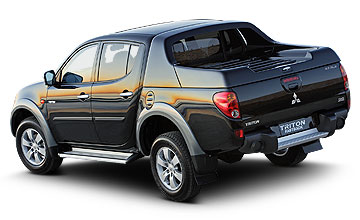BY LUCIANO PAOLINO AND PHILIP LORD | 5th Jun 2009

Yet there are a few inching their way closer to cars, and one such ute is the Mitsubishi Triton GLS Fastback.
The Triton GLS Fastback is top of the tree in the Triton range, with the luxury of leather and the safety of full-time 4WD and optional side and side curtain airbags. It costs around the mid-$50k mark. That’s about Pajero money. But is it worth it?
It’s a hard question to answer, because on one hand, the Triton is still a separate chassis, leaf-sprung live rear-axle two-tonne ute with the ride and handling shortfall that implies, but then it is also a well-appointed and specified truck, arguably the best of the one-tonne utes for the maximum five occupants. Among the Japanese and Korean utes, the Triton is the only one to offer the fine blend of part-time/full-time 4WD and (optional) side and side-curtain airbags.
The Triton’s interior is, like most of the one-tonne dual-cab utes on the market, is similar to a modern car interior, although in the Triton’s case it requires a bit of a step up to get there. Once you’ve settled in behind the wheel, you can easily forget you’re in a commercial vehicle. Black leather seats, carpet and brushed silver dash accents will do that.
Besides looking good, the Triton interior is also functional. There are no problems with the instruments or controls and finally the Triton has cruise control.
The audio system is simple to use. Gone are the miniscule buttons with illegible markings, for which Mitsubishi was famous.
Rear vision involves some guesswork, especially with the Fastback’s thick D-pillars, although vision to the front and side are good and side mirrors are a decent size.
The seats are firm but offer little lateral support. The rear seat is surprisingly accommodating, with a wide door opening and plenty of room.
The Triton GLS Fastback’s hard tonneau cover sits on (optional) struts and is easy to access the load area, even though the T-piece handle with integrated lock is a bit low-rent. I’m sure it’s the same handle design as on my grandfather’s garage, new in circa 1973.
The Triton has one of the smallest trays in its class, and the GLS Fastback’s payload is nothing special (870kg) and the maximum-braked towing capacity (2500kg) doesn’t match the best in class. Still, you probably don’t buy a vehicle like this for maximum hauling abilities.
The Pajero’s Di-D 3.2-litre turbo-diesel is fitted to the 4WD Triton, although it is a generation behind the recently revised Pajero engine. Even though performance is strong overall, it is surprising that Mitsubishi couldn’t fit a five-speed auto instead of the four-speed unit. Even though the 3.2-litre engine performs well, has minimal turbo lag and a solid, punchy mid-range, it is clattery and isn’t by any means the most silken in its class.
We averaged 10.7L/100km in a combination of city and country running – not bad for a two-tonne diesel auto 4WD.
The Triton has accurate enough steering and a responsive chassis and firm suspension.
While weight, traction and geometry will work against the Triton being a ‘sporty’ drive, it can still be an enjoyable vehicle to drive at a brisk pace. Push too hard though and body roll and understeer become the norm, and even in 2WD mode the Triton feels less inclined to step out than some of its competitors.
The full-time 4WD makes this ute one that doesn’t need to tiptoe on greasy roads. It gets traction when other vehicles slither.
The Triton has ample ground clearance and satisfactory approach, ramp-over and departure angles (although the GLS’s side and rear steps will soon be damaged off-road you would take them off if you were serious), good off-idle response, wheel travel and over-bonnet vision. Added to that is an excellent rear diff lock, and the Triton is as good as you will get for a one-tonne off-road weapon.
For the critics, Triton appears to be primitive jack-of-all-trades and master of none, but it is easy to see the persuasive argument for the dual-cab ute, especially one as well rounded as the Triton GLS Fastback.